BY MICHAEL LOREN SIEGEL
Introduction
The work of British-born filmmaker Tony Scott has undergone a major critical revision in the last few years. While Scott’s tragic suicide in 2012 certainly drew renewed vigor to this reassessment, it was well underway long before his death. Already by the mid-2000s, Scott’s brash, unapologetically superficial, and yet undeniably visionary films had been appropriated by auteurists and film theorists alike to support a wide range of arguments.[1] Regardless of what we may think of the idea of using auteurism and theory to “rescue” directors who were for decades considered little more than action hacks—an especially meaningful question in the digital age, given the extent to which auteur theory’s acceptance has increased in direct proportion to the growth of online, theoretically informed film criticism—it would be difficult to deny the visual, aural, narrative, thematic, and energetic consistency of Scott’s films, from his first effort, The Hunger (1983), all the way through to his last, Unstoppable (2011). The extreme scale and artistic ambition of his films, the intensity of their aesthetic and affective engagement with the present (a present defined, as they constantly remind us, by machines, mass media, masculinity, and militarization), and, indeed, the consistency of their audiovisual design and affect (their bristling, painterly flatness, the exaggerated sense of perpetual transformation and becoming that is conveyed by their soundtracks and montage, the hyperbolic and damaged masculinity of their protagonists)—all of this would have eventually provoked the kind of critical reassessment we are seeing today, even without the new mythos produced around Scott upon his death.
Indeed, Scott’s films—especially his late films, beginning with Man on Fire (2004)—have been among the most useful (and are certainly among the most pertinent) for the study and theorization of what Steven Shaviro has called “post-cinema.” Scott’s films, for several reasons, are an excellent terrain upon which to build a theory of what becomes of cinema as an art form, as a generator of effects and affects, “when it is no longer a cultural dominant, when its core technologies of production and reception have become obsolete, or have been subsumed within radically different forces and powers” (Shaviro, “What”). Technologically, economically, socio-culturally, and aesthetically, Scott’s films are indelibly stamped as “cinematic.” They are pure, almost Platonic distillations of late Hollywood spectacle, affect, and intensity. But at the same time, because they are so powerfully involved in and imbricated with the techno-media realities of their contemporary moments, Scott’s films are also particularly attuned to emergent social forces and powers. Hence their interest for theorizing post-cinema, where the very name of the game is to grasp, in and through cinema and (usually) popular moving-image culture, the becoming-something-else of everyday experience in an era of digitization and neoliberal economic relations.
Indeed, digital technologies and neoliberalism, Shaviro notes, “have given birth to radically new ways of manufacturing and articulating lived experience” (Post-Cinematic 2). Scott’s films, I want to suggest, indicate, analyze, and participate in the production of this new form of lived experience. The concept of the post-cinematic is valuable precisely to the extent that it counters the elegiac tone surrounding the “death of cinema” and helps us trace, instead, the new and vital ways in which cinema can be uniquely expressive (that is, both symptomatic and productive) of new forms of experience despite, and also, crucially, because of, its culturally residual status in the twenty-first century. If the endgame of the concept of the post-cinematic is “to develop an account of what it feels like to live in the early twenty-first century” (Shaviro, Post-Cinematic 2), then Tony Scott’s films, made between 1983 and 2012, a period of time practically isomorphic with the rise of both neoliberalism and the digital, are remarkably rich critical sites.
Although there is a marked avoidance of precise periodization in Shaviro’s post-cinema argument, it is clear that the emergence of the post-cinematic as the dominant affect, “structure of feeling,” and epistemic foundation of everyday life took place across this same time period (the early 1980s through today). Thus Scott’s career spans the transition from the cinematic to the post-cinematic, a transition in which he was a central figure for a number of reasons. Two of the most overlooked of these are the ways in which a) his films focus on the relationship between humans and machines, especially machines with screens (a relationship increasingly defined—in both reality and in Scott’s films—as a simultaneously mental, sensorimotor, and embodied relation of extension, immersion, assemblage, or interface), and b) these films seem to want both to represent and to render a major transformation in the nature of the screen itself as an aesthetic, technological, and architectural object or artifact. Tony Scott’s films, in short, use formal, stylistic, and narrative elements specific to cinema to both reflect upon and help produce a major reconfiguration in the parameters and possibilities of the screen as the terrain upon which media take on consumable form for an end-user (or spectator, to draw upon an older lexicon). Scott’s films reconceptualize the screen, positioning it no longer simply as a coherent, self-same, and empty plane that reflects projected images and worlds back at an illusorily unified spectator who, in turn, is psychically projected into the diegesis via identification structures (which would be something like the “cinematic” mode in its most classical form), but rather as a heterogeneous and modular zone of action and event that interfaces with a user now also reconceived as multiple, mobile, and physically, perceptually, and cognitively adhered to, affixed to, or fused with the screen itself. These films, in other words, produce something that emulates a digital screen experience avant la lettre. Scott’s films, then, “cinematic” as they may be, gesture towards post-cinematic forms of both spectatorship and screen.
This is most obvious in the late films, reaching a climax in 2005’s Domino, a film that uses analog filmmaking technology to produce a screen-subject interface that resembles that of portable, digital screens on smart phones and tablets, which were soon to dominate the social landscape. But what I am calling Scott’s reconfiguration of the screen/spectator relation begins quite early in his career, as early, in fact, as the mid-1980s. One of my motives in making this particular argument is to add a crucial dynamic to the growing discourse surrounding the concept of the post-cinematic: namely, the role of the screen as an ever-transforming object that is at one and the same time an interface with an ever-transforming subject.
But another motive is to begin to historicize the concept of the post-cinematic, to begin to conceptualize its emergence, which I am situating (following Lev Manovich) around 1985 or 1986, the moment of the first “domestication” or rendering everyday of digital technologies (Manovich, Software 13). In this vein, I will focus this chapter on one film that—for reasons, I think, of the film’s overt and seemingly non-reflexive ideological resonances with Reagan-era U.S. militarism—has not been sacralized or critically revisited in the same way that many of Scott’s other films have. That film is Top Gun (1986). As I will demonstrate, Top Gun gives us a unique and privileged glimpse into the emergence of post-cinema amidst significant shifts in the techno-social terrain of the mid-1980s.[2] In many ways and on many levels (style, narrative, mode of address, technique), Top Gun concerns itself if not directly with the rise of the digital per se, then certainly with the shifting nature of self and subjectivity in relation to a transforming techno-media sphere, translating these concerns into a unique approach to screen space and mode of address. Once we historicize the film alongside the emergent everydayness of digital culture in the 1980s (1985 and 1986 were watershed years for the development, marketing, experience, and rhetoric of contemporary media technology, especially digital media technology), it becomes clear that this film, in addition to whatever else it might be, is explicitly about the point of contact between the human sensorium and the techno-media sphere, as well as the powerfully transformative mental, affective, bodily, erotic, and epistemic effects that this encounter has.
Furthermore, Top Gun stages this encounter in multiple ways. The first and most obvious is diegetically: the film’s story world is that of elite Naval pilots learning to master high-tech fighter jets, all of which are equipped with and monitored by various screens, most notably the pilots’ missile lock screens, which are always seen in point-of-view. The second, less obvious way, is via mode of address. Using the same radical approach to film style and screen space that would later authorize critics to canonize Scott as an auteur, Scott here presents a new—for the time—spectatorial experience defined by a form of immersion that, I will argue, emulates the human-machine assemblage produced and promised by digital interfaces.[3]
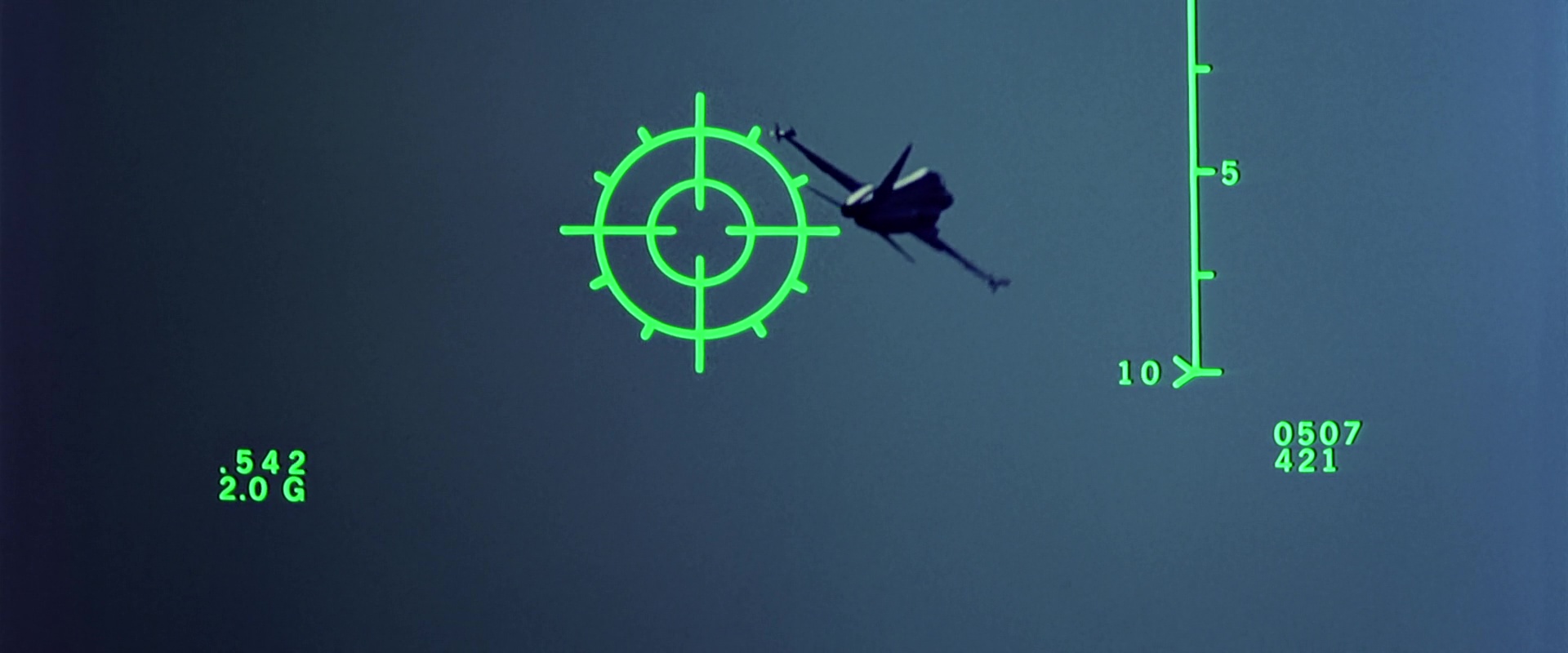
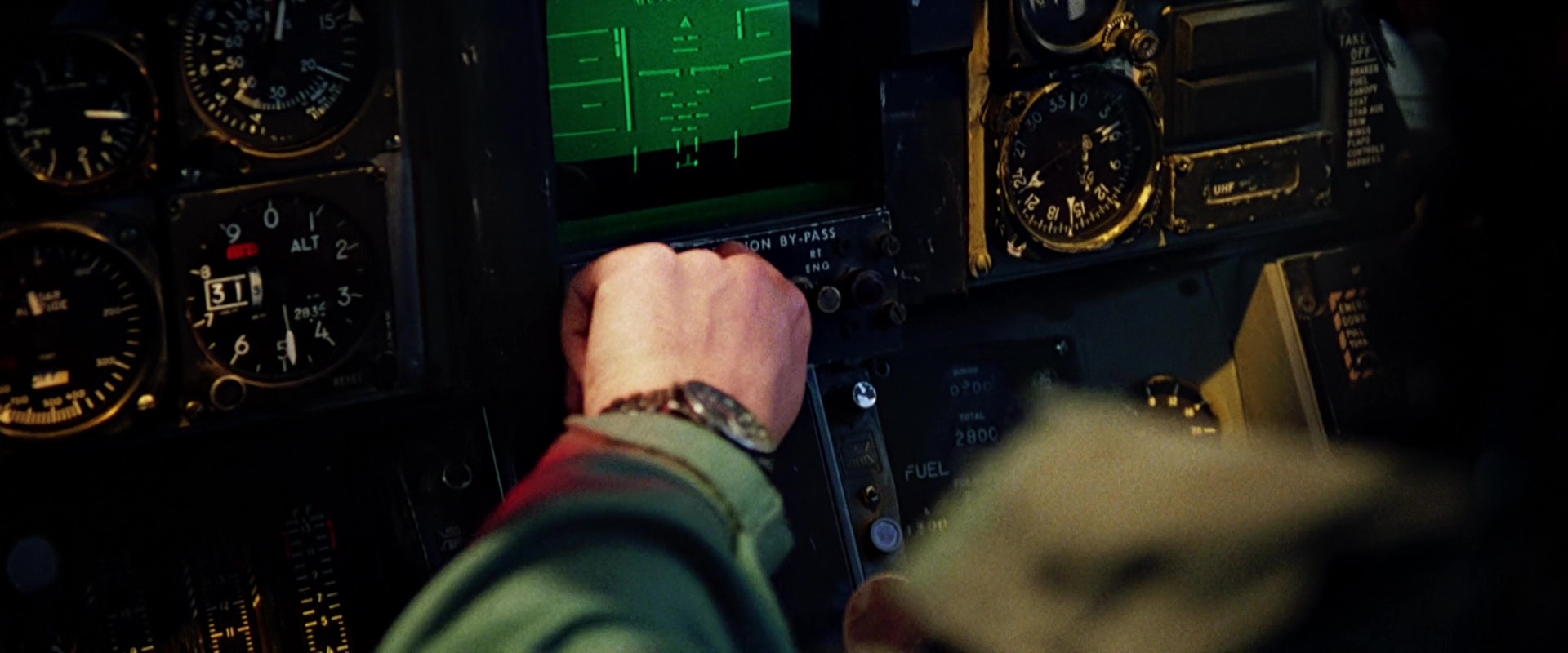
Top Gun thematizes this mode of address, in turn, positing the space between the spectator and the screen as a kind of “danger zone,” one in which the experience of being a spectator is, like that of being a character in the film, a high-stakes game of “staying cool” (that is, retaining the safe distance and security of classically Oedipalized cinematic identification and voyeuristic visual pleasure) vs. “getting burned” (submitting to total, Thanotic immersion in an image that seems to want to burn right through the screen, directly addressing the body and obliterating the distance and distinction between viewing subject and viewed object). In a very real sense, in Top Gun, the spectator is to the film screen as the elite pilots are to their F-14s and MiGs: not just buckled in but burned in, not just interpellated but intercalated, not just a pole in a dyad whose “third term” is distance, but part of an assemblage defined by contact, closeness, and erotic coupling. Top Gun, in this sense, must be seen as a kind of limit film, just as it is thematically and stylistically obsessed with limits: it self-consciously pushes many of the tropes of 1980s action cinema (one of the central ideological sites of early neoliberalism and a cinema that was highly influential in the shift towards post-cinematic forms of affect and cinematic enunciation) to their extremes while at the same time flirting with the boundaries of the cinematic as a techno-media regime defined by a certain configuration of the screen itself (fixed, flat, singular), of screen space, of spectatorship, and of affect.
My use of Top Gun to map out something like the beginnings of a trajectory towards the dominance of post-cinema has one other important stake: namely the proposition that post-cinema is not to be confused with digital filmmaking per se. Rather, I wish to use the concept of post-cinema to help pin down a certain set of shifts that show up in sites that are traditionally thought of as “cinematic” (screen space, film style, and narrative) but that indicate transformations on a deeper and broader cultural level as the digital takes over as a dominant epistemic logic. Since Top Gun was produced and released during a transitional moment, the film is, as we would expect, defined by a tension between cinematic and post-cinematic modes. The questions around post-cinema that it raises are therefore—obviously—not about the ontology of digital cinema, but rather about the impact of the digital precisely as a mode of consciousness or structure of feeling on the possibilities of cinema, regardless of its technological base. What happens to cinema, Top Gun asks, not when cinema becomes digital but when experience itself begins to become post-cinematic?[4]
Technophilia/Technophobia: Historicizing Top Gun
The most common critical interpretations of Top Gun are based on ideological, and specifically psychosexual readings. Top Gun is customarily seen as the near-perfect incarnation of Reagan-era ideologies surrounding masculinity, virility, and paternalistic nationalism, as well as one of the paradigmatic examples of the “high-concept” action film pioneered by the team of Jerry Bruckheimer, Don Simpson, and Tony Scott.[5] Top Gun was, indeed, deeply imbricated with 1980s American imperialist ideologies, so much so in fact that, as Stephen Prince and others have noted, it had a powerful effect not only on subsequent action films, but also on the overall aesthetics and address of military recruitment itself, introducing a sense of the erotic to the image of the military:
The U.S. Navy admitted that it regarded [Top Gun] as a recruiting ad, and the movie’s structure employs the montage editing, minimal dialogue, and pervasive use of rock music to establish mood and theme that have become staples of MTV and that producers Jerry Bruckheimer and Don Simpson had perfected in their earlier work. Much of the film’s strategy in this regard is to use these cinematic elements to eroticize the planes and weaponry and the bodies of the students and teachers at the “Top Gun” school. (Prince 71)
Top Gun, in other words, worked to naturalize, to render palatable (and even sexy) the Cold War logic of everyday militarization and the new geographies of the 1980s: in Top Gun, “we can see clearly how the imagery and rhetoric, the very forms and objects, of real-world consumer culture and leisure pursuits were fused with the psychological and emotional dynamics of the Cold War” (Prince 70).
It would be foolish to deny that Top Gun is, at least in part, defined by a highly problematic, masculinist, militarist Cold War ideology.[6] However, this ideology does not completely define the film. Top Gun (and, indeed, the “high concept” film in general) can also be critically situated within the adjacent and broader history of media and technology, along with the new senses of time, space, speed, scale, subjectivity, and embodiment that they both indicate and help bring into existence. Whatever else Top Gun is—a feature-length, Oedipal airborne music video about the restoration of the Reaganite patria, the first of many sexy, “golden hour,” “Miller time,” Navy recruitment ads, one of the most easily “queerable” texts in Hollywood history, etc.—it is also explicitly about the interface between the human and technologically advanced machinery.
One of the key elements of the film in terms of style, production, and mode of address is its technophilia: as Prince notes, it quite conspicuously and shamelessly posits high-tech weapons technologies as objects of erotic spectacle and audiovisual (cinephiliac) pleasure, as well as vehicles of “intense,” invigorating bodily experience. The erotics of the film incorporate not only Maverick’s (Tom Cruise) affair with his teacher Charlie (Kelly McGillis) and the much discussed slow-motion, sweat- and oil-soaked, half-naked bodies of the “Top Gun” pilots as they shower and play beach volleyball, but also the sexy lines of the F-14s themselves—their gleaming, silver, phallic bodies and vermilion, deep gold after-burners rendered painterly and with “feminine” softness through the use of long lenses, color filters, and smoke effects against the backdrop of rich, pastel sunsets and azure skies.

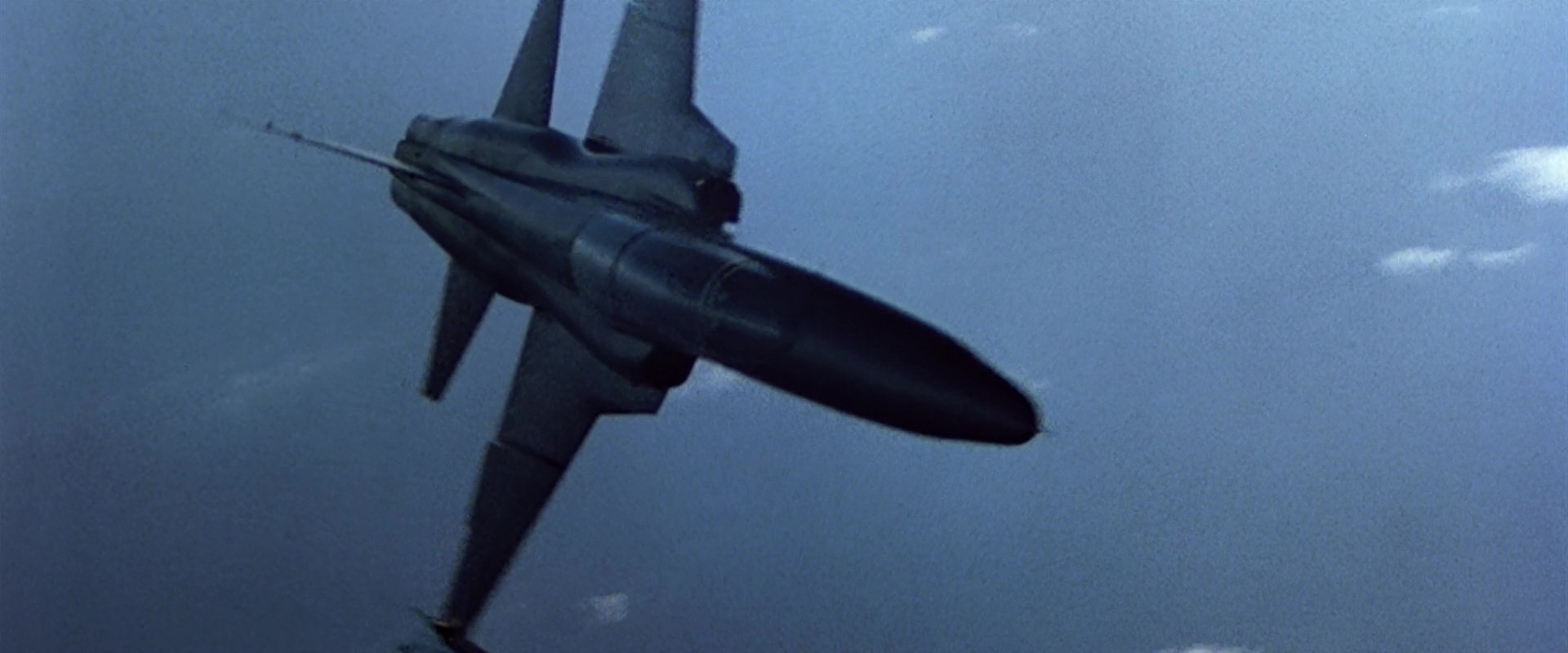
This connection between embodied sexuality and the erotics of war machines is also cued by scripting and dialogue, as for example, when Maverick refers to a singles bar as a “target rich environment” and another “Top Gun” pilot talks about the “hard-on” that the sight of the enemy MiGs gives him.
Not surprisingly, given this eroticization of technology, the film also features a healthy dose of technophobia as well. Maverick’s entire story, in fact, hinges on a kind of mental dissolution and bodily breakdown in relation to technology that is carefully encoded by the film as a form of sexual impotence, mainly through the use of heavy breathing, foreboding music, and nervous sweat. The overall picture that the film paints is of a human male body whose worth (or worthlessness) is measured by its ability (or inability) to properly and successfully couple with advanced technology, a form of technology which, furthermore, provides its users with their only frame of reference and set of metaphors for understanding themselves and their erotic drives.
This complex and multi-faceted depiction of the human vis-à-vis technology is symptomatic of the intense transformations taking place in the role, reach, rhetoric, and realities of technology, media, and popular culture during the mid-1980s, a set of transformations that was also intimately connected to the rapid ascent of neoliberalism as a form of both political technology and geography. As I mentioned above, the period surrounding Top Gun’s production and release (1985-86) was, according to Lev Manovich, “the moment when domestication of computers and software starts, eventually leading to their current ubiquity” (13). In addition to heaps of anecdotal accounts from artists and cultural producers regarding their first sighting, in the mid-1980s, of a digital media device, this techno-social moment also featured the following geopolitical, pop-cultural, and media-technological developments:
In geopolitics and space technology:
1) The coincidence of Reagan’s second inauguration, after a re-election campaign that revolutionized the use of mass media and cinematic affect, with the ascension of Mikhail Gorbachev to General Secretary of the Communist Party of the Soviet Union—together two of the initial steps on the short but tortuous path towards the dismantling of the entire Communist Bloc and the creation of a global neoliberal political economic sphere.[7]
2) The establishment of the Schengen Area, hence the official institution of a Europe without national border controls.
3) The discovery of the first ozone hole, and with it the confirmation of environmentalists’ worst fears around the scale of technological modernity’s environmental destruction.
4) President Reagan’s first public mention of the word “AIDS,” and hence the beginnings of the global understanding of AIDS—which had previously been experienced as an unspoken “threat” that only affected gay men—as a public health crisis.
5) The Challenger disaster, which complicated one of the Reagan administration’s key political narratives, that of human progress-through-technology.
6) The Chernobyl disaster and the launching of the Mir space station.
In popular media culture and media technology:
1) The recording and release of the charity single/music video “We Are the World” for famine relief in Africa by a supergroup of several of the biggest stars of the American recording industry of the 1980s, a project that helped solidify the notion that “progress” under neoliberalism was to be equated with episodic acts of philanthropy and charity, rather than with real structural change.
2) The introduction by Minolta of the Maxxum 7000, the first camera featuring the combination of a single-lens reflex system, auto-focus, and automatic frame advance, and hence a major step towards the everyday domestication and automation of photographic technology, a process that would eventually result in the vast proliferation of digital image-making devices.
3) The release of both the Nintendo Entertainment System (and the highly influential, enormously popular Super Mario Bros.) and Commodore’s Amiga Home Computer (the first multimedia personal computer with advanced graphics, sound, and video, as well as an early example of GUI-centric computing). Two versions of Top Gun the video game—both of which adapt the point-of-view of the film’s jet fighter pilots into proto-first-person shooters—were released for Nintendo, IBM PC, Commodore, and Atari in 1986.
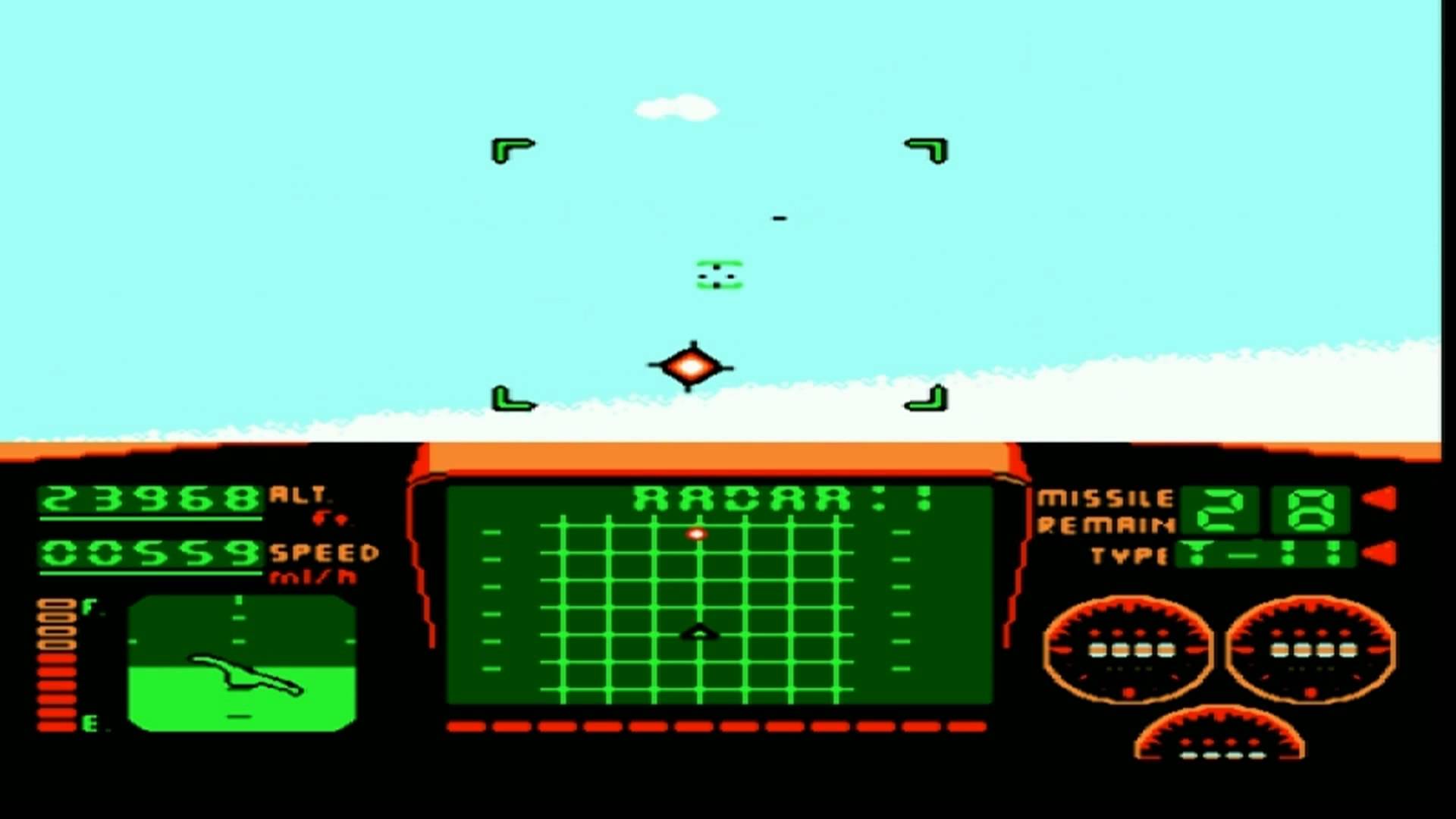
4) The release of Dire Straits’ Brothers in Arms, the first album to sell over a million copies on compact disc.
5) The founding of Pixar Studios and Microsoft’s initial public offering, two brands that have been definitional for digital culture.
6) The production and widespread dissemination of the first IBM PC virus, (c)Brain, and with it the growth of the notion of a shared, digital ecology.
7) The publication of Howard Rheingold’s book Tools for Thought: The History and Future of Mind-Expanding Technology, Lev Manovich’s “all-time favorite book,” the key insight of which was “that computers and software are not just ‘technology’ but rather the new medium in which we can think and imagine differently” (Manovich 13).
8) The release of Jeff Stein’s highly influential music video for The Cars’ “You Might Think,” one of the first videos to use computer graphics and compositing systematically and extensively, the winner of “Best Music Video” at MTV’s first annual music awards and, according to Manovich, an enormous influence in the design world (280).[8]
This period, in other words, witnessed some of the most important developments in: a) the history of technology in general, especially media technology and in particular its growing fusion with everyday experience (and everyday fantasies of technology) via home image production and consumption and new, interactive, digital and software-based media platforms and brand names; b) the development, thanks in part to these technological shifts and to the public spectacle of environmental, technological, and corporeal (self-)destruction, of our contemporary understanding (always also a misunderstanding) of global ecology and spatiality; and c) the increasingly global consolidation of neoliberalism as a political technology reliant upon media, spectacle, and machinic technology, along with the media spectacle of machinic technology. What we see brought together in this period, in other words, is the triumph of neoliberalism, the emergence of an entirely new techno-media regime, and the beginnings of a new mode of feeling, experiencing, and understanding the world related to this new techno-media regime.[9] What we see, in other words, are the very first inklings of digital neoliberalism, or what we are in this volume calling the “post-cinematic.” All of this, I am arguing, is reflected in Top Gun’s own symptomatic relationship to technology, and the film indicates this emergence and these transformations (just as we would expect it to do) sometimes directly and sometimes obliquely.
The Further on the Edge, The Hotter the Intensity
On almost every conceivable level, Top Gun is a film that is obsessed with edges, boundaries, limits, and the transformative, erotic, and destructive intensities and energies associated with living amidst and transgressing them. The boundary that gets the most attention is that between the human and the technological. This obsession, I would like to suggest, is the chief way in which the film figures the media technological shifts of its surrounding period along with the new human-digital interfaces and assemblages that these shifts produced.
The film wastes no time introducing these themes. As the credits roll, we see shots of an F-14 being prepared for takeoff. In their slow-motion, long-lensed, high contrast, color-filtered eroticization of (war) machines and the fetishistic loving care and sexual attention given to them by humans, these images seem stolen from a Kenneth Anger film on methamphetamines.
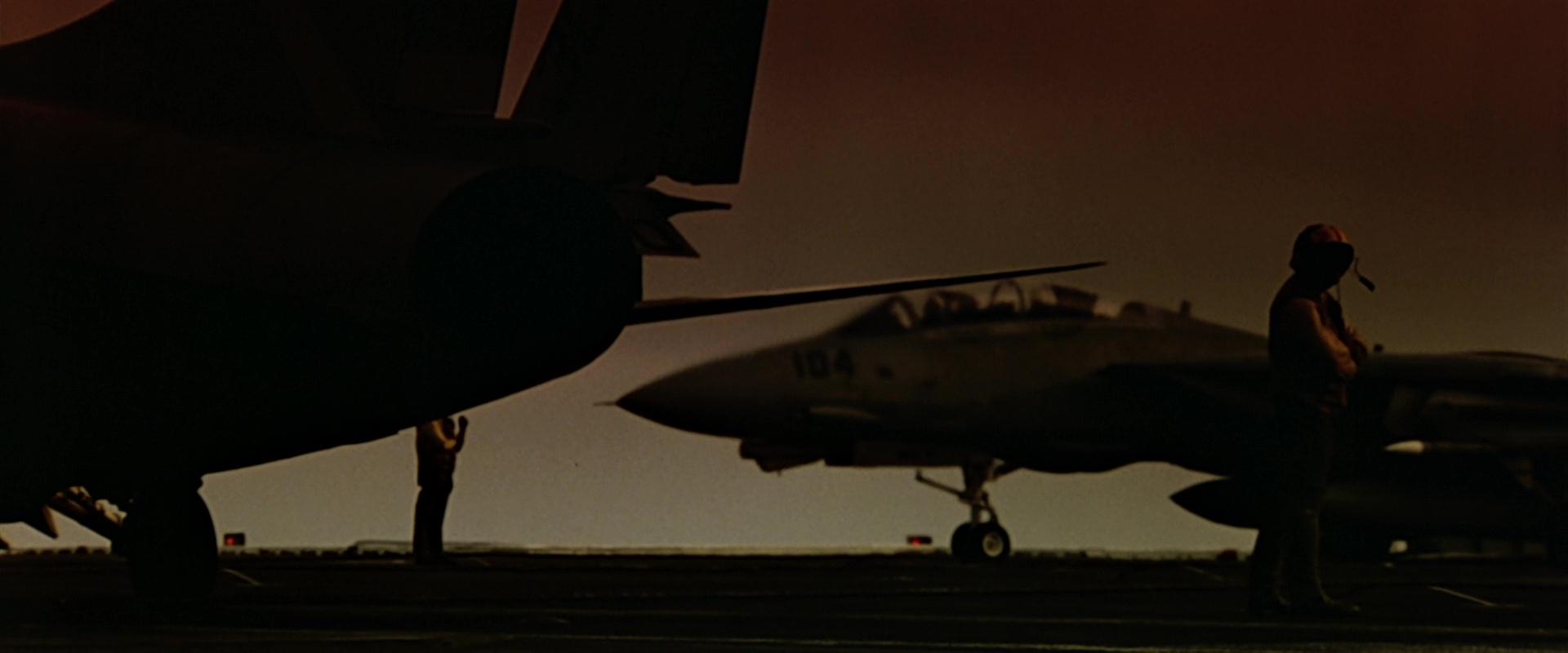
And just as we see in Anger’s cinema, Top Gun’s musical choices rhetorically double the film’s depiction of technology and the human-machine interface as sites of both danger and desire. While these initial images and credits roll, the music on the soundtrack is Harold Faltermeyer’s Wagner-meets-Santana, erotic synth-rock “Top Gun Anthem”: its familiarly raunchy, anthemic, electric guitar climax is heard both at the film’s narrative climax and in quieter, tamer versions each time the film touches upon Maverick’s relationship with his dead father. Once the F-14s afterburners fire and Tony Scott’s directorial credit hits the screen, however, the music abruptly shifts to Kenny Loggins’s hit song “Danger Zone,” the lyrics of which draw explicit connections between transformation and becoming, sexual intensity and orgasm, technologies of speed and destruction, and the idea of penetrating boundaries as a form of interfacing or coupling:
Revvin’ up your engine
Listen to her howlin’ roar.
Metal under tension
Beggin’ you to touch and go.
Highway to the Danger Zone.
Ride into the Danger Zone.
Headin’ into twilight,
Spreadin’ out her wings tonight.
She got you jumpin’ off the deck
And shovin’ into overdrive. . . .
They never say hello to you
Until you get it on the red line overload.
You’ll never know what you can do
Until you get it up as high as you can go.
Out along the edge
Is always where I burn to be.
The further on the edge
The hotter the intensity. (Loggins)
This concept of the boundary between the human and the technological as a kind of “danger zone” and the (rather Thanotic) affective matrix of these opening images and sounds do, indeed, define the rest of the film on several levels. Top Gun’s setting, for example, is a Naval fighter pilot training school, a social environment defined by male competition and the demand that students abandon their familial structures and effectively exceed themselves (and even, if only in small doses, the structures of the institution itself) in order to achieve an impossible level of excellence. The most common conversation overheard in the “Top Gun” school is about who is “the best of the best”—a superlative, aspirational label that is nonetheless, time and again, posited as attainable, objectively verifiable, and dependent upon specific psychosexual and proprioceptual variables within the pilots themselves. Top Gun’s characters regularly push themselves to and beyond their physical, cognitive, and psychosexual/affective limits in order to achieve this “best of the best” label. The key limit that they must transcend is that between themselves and their jets: in several ways (gestural acting, dialogue, sound and editing, and, as we will see, spatial compression in the image), the film indicates that the very “best” pilots (both students and instructors) are those who are able to couple (erotically) with their machines while not losing themselves in the “danger zone” of this coupling. The “best” pilots, in other words, are those who are able to fuse with their jets in mind, body, and spirit while still maintaining their “proper” position of masculine self-control and (sexual) dominance over their (eroticized) machines.
Ultimately, however, the question of who is “the best of the best”—who is “on top”—will come down to the heavily psychologized relationships of individual characters to their own limits as erotic beings: hence the competition between Maverick, who “flies by the seat of his pants” and constantly ignores his superiors’ orders because of his severe (Oedipal) issues with authority, and Iceman (Val Kilmer), who follows orders with precision and—boringly—“flies ice cold, no mistakes.” While Iceman wins the official nomination of “the best of the best” at a ceremony near the end of the film, the film’s own audiovisual discourse and narrative arc make it abundantly clear that Maverick, the one who lives on the edge and draws energy from the “danger zone”—that is, who allows the erotic encounter with the F-14 to at times subsume and obliterate him—is actually “the best of the best.” In a real-world battle (not to mention in the closely aligned terrain of the bedroom) when actual (or metaphorical) death is on the line, Iceman is clearly in an inferior position. He is a wingman, his famous, final attempt to gain “top” status—“you are dangerous, but you can be my wingman anytime”—confidently and flirtatiously rebuffed by Maverick’s “bullshit, you can be mine.” It is worth noting, furthermore, that geographic boundaries and their penetration are absolutely central to the film’s narrative as well: it is precisely an unknown enemy Other’s “violation of air space” which initiates the narrative, thus putting all of these issues surrounding the eroticization of machines, speed, and limits into play in the first place.
I am clearly pushing a queer reading of Top Gun here (one that is increasingly common in more contemporary reception of the film), and this is partially to counter more “closed” ideological readings (by far the most common), which tend to see the film as conveying a dominant, masculinist-militaristic-misogynistic/paternalistic, Reagan-era ideology purely and directly, without slippage of meaning or desire.[10] But it is also partially because the queer perspective allows us to see the particular erotics of this film in a new light, especially in terms of limits, desire, transgression, and technology. While, as I will demonstrate, the film implicitly posits a rather standard erotically transgressive, “death drive” theory of queer male sexuality (one that seems cut to the measure of the work of theorists like Leo Bersani and Lee Edelman), it also couples this erotics with the exploration of other kinds of limits. Indeed, I will also argue that Top Gun unseats traditional cinematic subjectivity (a subjectivity customarily encoded and understood as fixed and rigidly heteronormative/masculine) by being a “limit film” at the level of form, style, and mode of address as well. By this I mean that, using as narrative motivation the fact that the film represents (explicitly) the “limit” experiences of helming a supersonic fighter jet and (implicitly) feeling the heat of one’s attraction to another of the same sex, Top Gun pushes many of the parameters of mainstream cinematic vision and narrative construction beyond their limits as well, ultimately addressing a new type of spectator for a new type of media-technological sphere.
Style, Space, and Spectatorship
Top Gun is defined by two conflicting visual styles. One of these is relatively classical and uses depth of field, shot/reverse-shot, eye-line matching, and coherent narrative-spatial construction to produce what psychoanalytic film theory would have called a “sutured” space. This is a space of well-oriented action for both the characters and the spectator, one that effectively renders the classical spectatorial pleasures of sensory-motor engagement and visual mastery. This style is used in most of the film’s more traditionally melodramatic, conversational sequences (of which there are many). The overall signification of this spatio-stylistic mode is “cinema” itself as a techno-representational regime.[11]
The other cinematic register, which is mobilized the rest of the time and is—importantly—the style with which the film begins and ends, is defined by the kind of delirious excesses that Tony Scott would be celebrated for later in his career. In all of the flight sequences as well as the film’s single actual sex scene (which plays like a thirteen-year-old boy’s fantasy of sexual intensity), extremely long telephoto lenses, color glass filters, smoke and colored light, graphic montage, slow motion, silhouette lighting, an amped up, pop-rock soundtrack, and other stylistic effects work together to produce an overpowering sense of closeness, flatness, and spatial compression.

Given the nature of the film’s narrative material, this makes sense: Top Gun is an action film, but the agents of action are not, for the most part, the bodies of the star protagonists (which would demand a three-dimensional, dramatic, classically “cinematic” space), but rather the film’s iconic F-14 and MiG fighter jets, machines whose engagement with time, space, and speed is entirely unassimilable to the human perceptual and proprioceptual apparatuses (except for those of the film’s superhuman heroes—a crucial aspect of Top Gun’s success as a form of military recruitment). Instead of presenting an illusory, anthropomorphized space of action that the viewer’s eye can plot and observe at a cool distance and that the characters’ bodies can properly traverse, much of the film is presented within a space that is cut to the spatio-temporal realities of the fighter jets themselves. Time and again, we see shots of F-14s and MiGs flattened against the sky like cutouts, and even more often, in what are without question the film’s most repeated and recognizable icons, shots of pilots compressed into their cockpits in long lens, frontal close-ups.
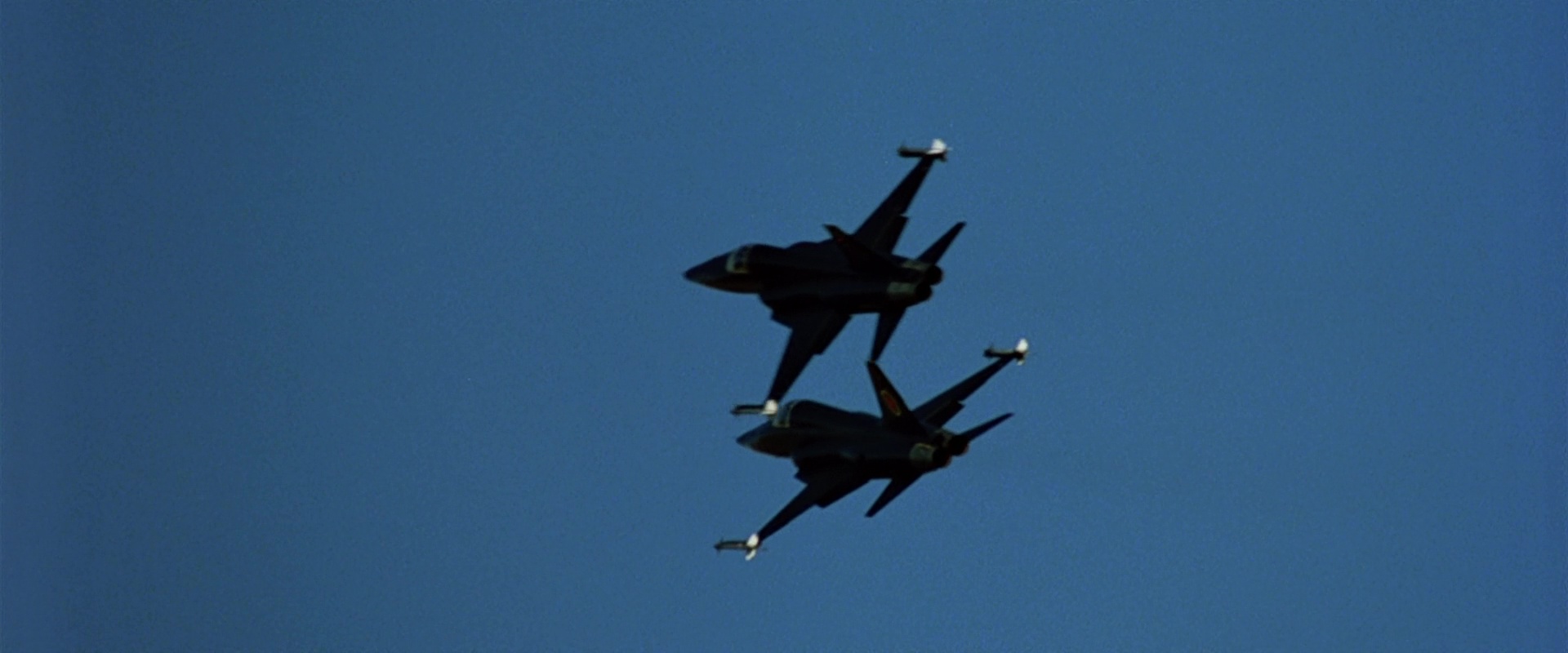
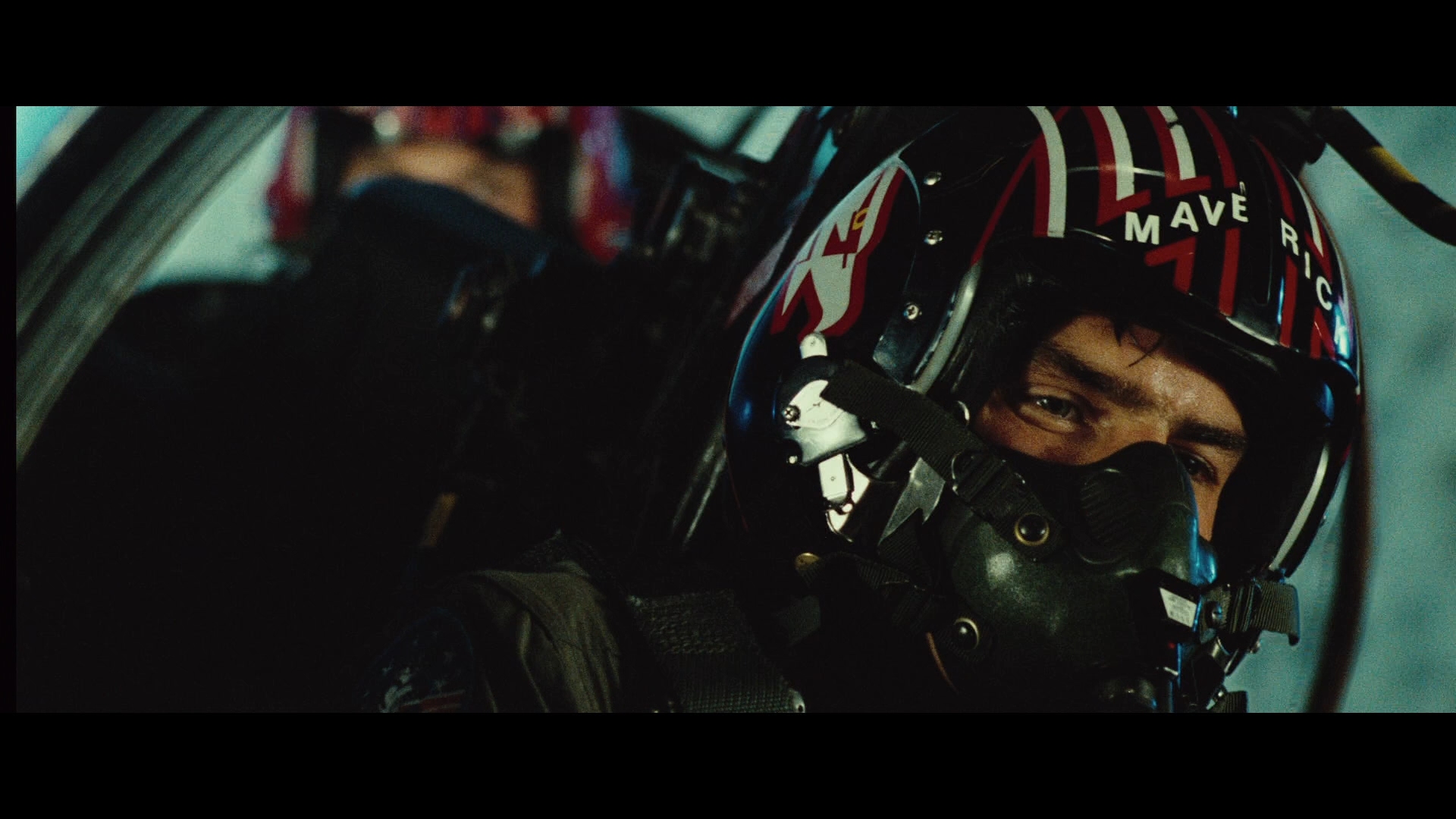
The film in this way creates a kind of flat technospace that foregrounds speed and intensity and invokes explosive possibility, one which the jets, appropriately, traverse using spontaneous and continually varying forms of motion.
The film then proceeds to insert the (superhuman, eroticized) bodies of the pilots into this space. Top Gun, in other words, functions like an erotic fantasy of what it might feel like to occupy what Deleuze and Guattari call “smooth space”: a non-formal, heterogeneous space that cannot be mapped or rendered visually, but can only be diagrammed (i.e., rendered experientially). “Smooth space” is “a space of affects, more than one of properties” (479). Top Gun, in other words, mobilizes a material-pictorial space rather than a Cartesian-dramatic one to convey to the viewer, via a haptic experience of the cinematic apparatus itself, a version of “smooth space.” All image elements are compressed as far as possible into the foreground to the point that the image seems almost to adhere to the screen itself, or to be burned into it.[12] In this way, the spatial experience of the pilots that the film renders on screen (one of spontaneous vectors, “lines of flight,” becoming, and immediacy) is rendered as screen for an (erotically) adhered viewer.
Steven Shaviro makes a similar argument about Kathryn Bigelow’s Blue Steel, a film that strikes me as quite similar to Top Gun on many levels:
Bigelow’s painterly compositions . . . are disorientingly tense and unstable, always potentially explosive, and filled with suggestions of movement. Her nightmarishly lighted cityscapes are not beautiful, illusory tableaux displayed before the camera’s gaze, but danger zones within which the camera itself is forced to move. . . . Bigelow both disrupts and heightens spectatorial pleasures, by consuming distance in a frenzy of calculated excess. Her images aren’t static or decorative, because she isn’t concerned with the dynamics of nostalgia, memory, and loss. Blue Steel is not an ironic or contemplative film: it is too kinetically agitated, and puts us too perturbingly in contact with appearances. (Shaviro, Cinematic 4, my emphasis)
The relationships of distance and closeness or contact that Shaviro is referring to here are, of course, those between the viewer and the filmed object theorized by apparatus theory in the 1970s. There are two distances on which classical identification and voyeuristic pleasure are said to depend: that between the film camera and the objects it films, on the one hand; and that, on the other, between the viewer and the screen. “To fill in this distance,” Christian Metz points out, “would threaten to overwhelm the subject . . . mobilizing the senses of contact and putting an end to the scopic arrangement” (60). The kind of Thanotic obliteration of the cinematic spectator that Metz seems to want to warn against is precisely what is most on offer in Top Gun. In the place of safe, voyeuristic distance, Top Gun produces a sense of radical proximity or contact between spectator, screen, and filmed object. Its cinematic images, as Deleuze would claim for all cinematic images, are not fundamentally representations but rather events: the experience of this film is, indeed, one of sensation before it is one of signification. In Top Gun, to borrow again from Shaviro’s reading of Blue Steel, “Sensation is disengaged from the transcendental conditions that are supposed to ground and organize it, as from the referential coordinates that allow us to locate and preserve it. Sheer appearance precedes any possible act of recognition” (Cinematic 12).
Just as its narrative is structured around an extensive exploration of psychosexual and geographic boundaries, in other words, Top Gun also uses style to explore the zone of encounter between viewer and screen, framing this encounter as well as a “danger zone” fraught with desire and possibility. The film does this in several ways. In both script and visual design, for example, Top Gun regularly mobilizes temperature metaphors as a way of describing varying forms of human, and especially masculine, behavior in relation to technology. From the first scene of the film proper, that of Cougar’s (John Stockwell) nervous breakdown when engaged with the enemy MiGs, the pressure that the “Top Gun” pilots, technicians, and personnel experience is figured visually and verbally as a form of heat.
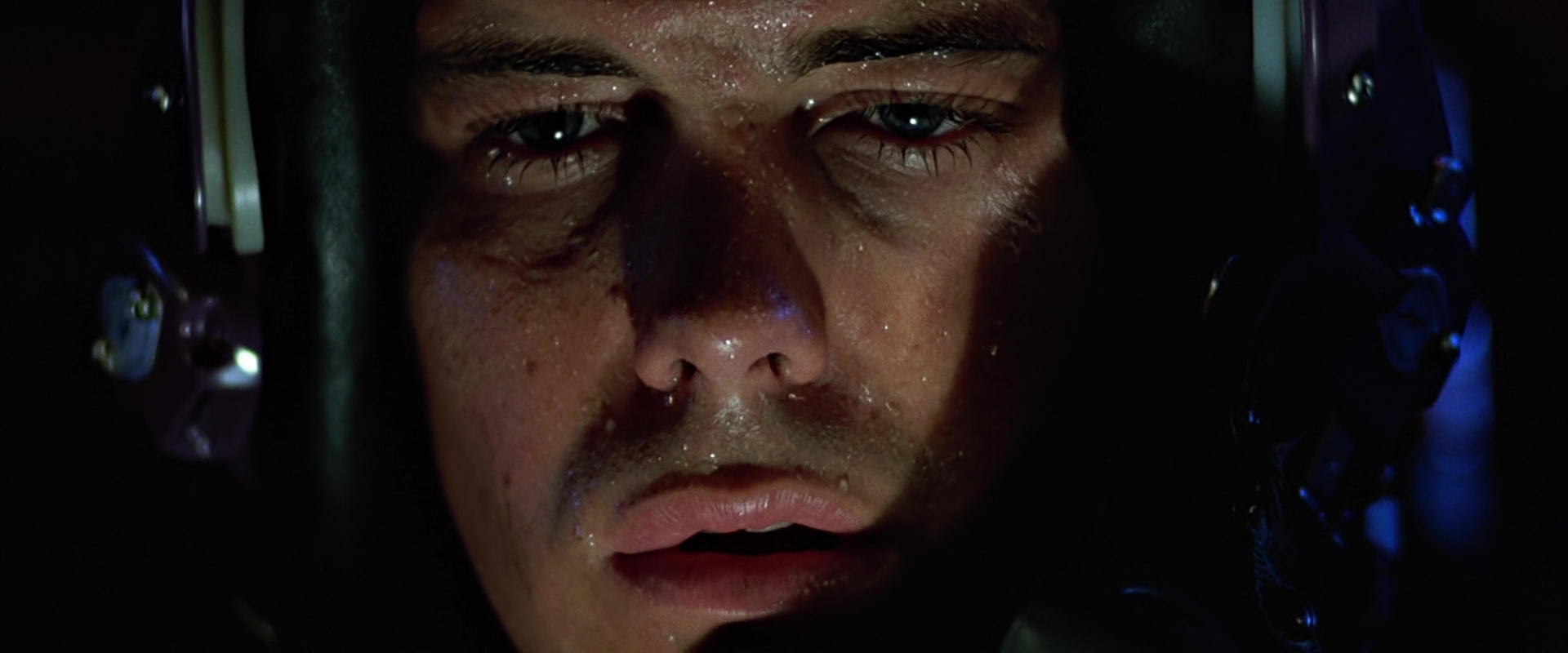
When in contact with this pressure and heat, some men can, as the dialogue tells us, “stay cool” (in other words, in a position of mastery over the machine and its radical energies and possibilities) and some, like Cougar and at points Maverick, cannot. They instead “get burned” by it: consumed, absorbed, and disintegrated. One of the chief visual signifiers that the film uses to indicate “getting burned”—i.e. the (hysterical) disintegration of the male body and psyche in the face of technology’s power—is a very classical one: sweat. Scott beads sweat on his male characters at several points throughout the film, most notably on aircraft carrier personnel during battle scenes, on Cougar and Maverick during their breakdowns, and on Maverick, Iceman, and Slider (Rick Rossovich) during the famous beach volleyball scene. In addition to the “hot” (and, in a genre stereotypically coded as hetero-male, non-normative) spectatorial desire of looking at men that sweat supports in the latter scene, sweat is also an index of stress or danger in Top Gun, and of the specter of failure, ego disintegration, impotence, and bodily breakdown—in short, of “losing one’s cool”—in the face of technology.
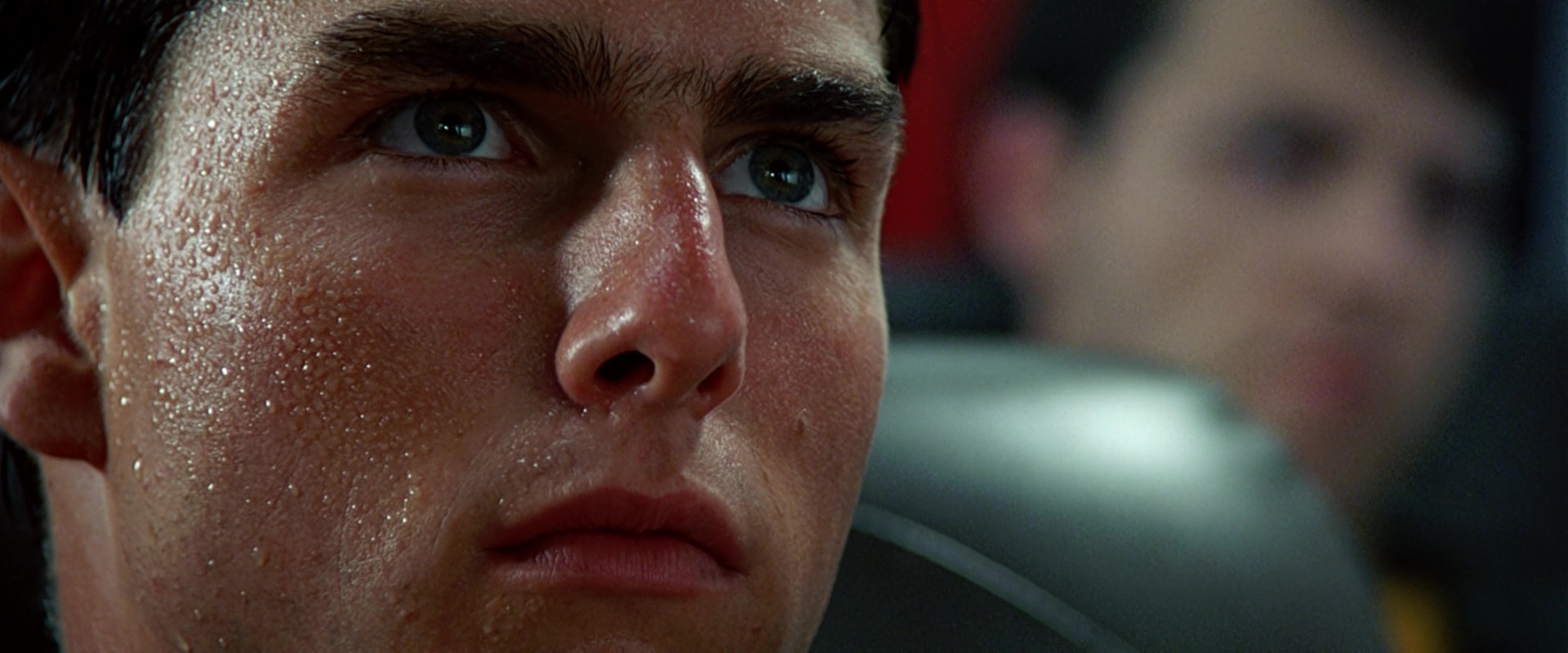
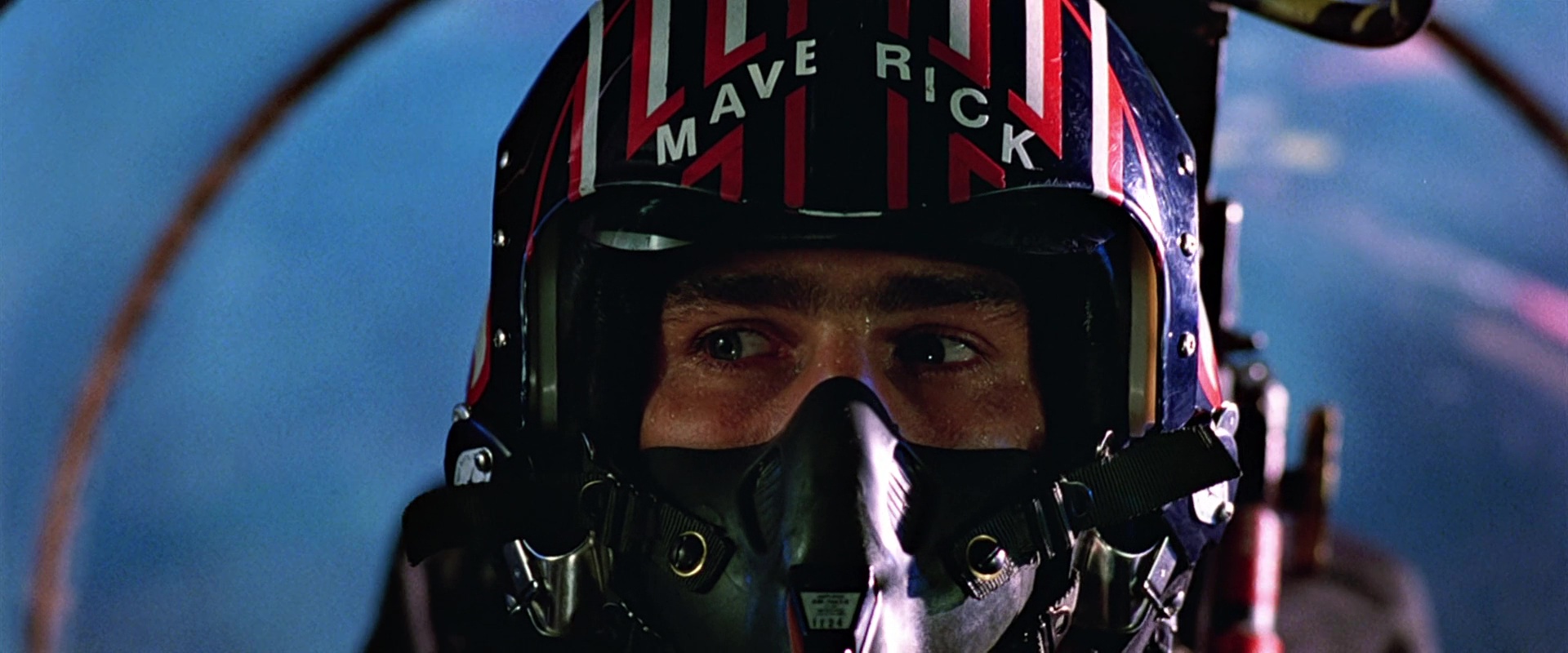
But sweat functions as more than just a signifier. As we know from Linda Williams and others, bodily fluids can be used by films to provoke an experience of corporeal sensation for the viewer as much as one of signification (see Linda Williams’s important “Film Bodies: Gender, Genre, and Excess”). Such is the case with sweat here. Sweat does not just “tell us” that the characters are experiencing stress, disintegration, and impotence; rather, it becomes another way in which the film effects a more embodied, more physical experience of the screen for the spectator. Just as the tear-jerking moments of the “feminine” genre of melodrama are often attached to stylistic figures like elaborate camera movements, musical crescendos, and highly expressive colors (which this film also features), sweat here is often accompanied by specific stylistic figures like minor-key, up-rhythm synthesized music, claustrophobic, oppressively geometric framing, and intense spatial compression in the image in the form of telephoto or inward zoom shots.[13] These all connect the narrative aspect of sweat with the visual register of flatness that, I have been arguing, is used to bring the image into closer contact with the surface of the screen and, by extension, with the spectator.
Concluding Thoughts
There is a link in Top Gun, therefore, between sexual desire and ego dissolution, bodily breakdown in relation to technology, spatial compression and flatness in the image, and a more embodied, embedded form of spectatorial address.
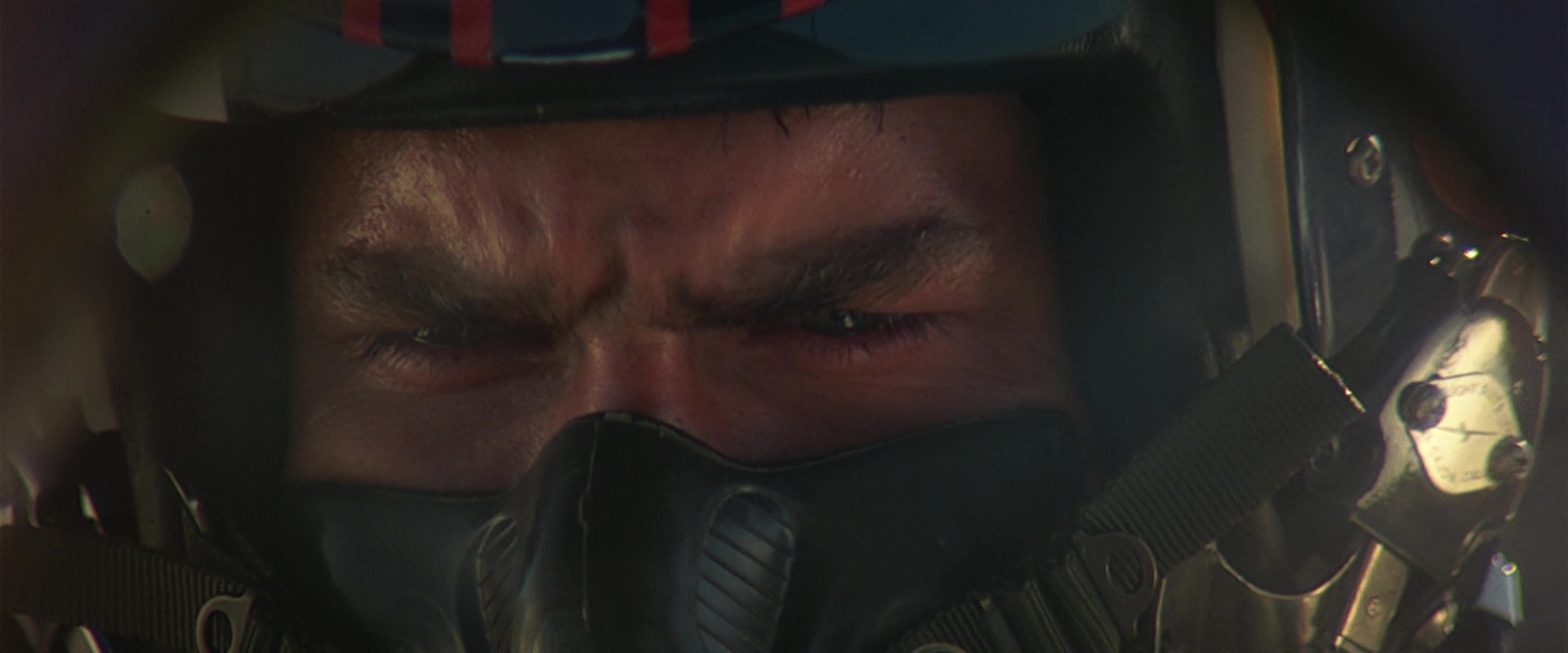
This matrix of textual effects allows us to see the (retrospectively, very obvious) queerness of the film as working in tandem with other aspects of its “limit” status. Just as the film counters the “hard body” masculinist films of its era precisely by reconfiguring and exaggerating them (that is, by explicitly externalizing the “hardness” of these male bodies into mediatic war machines that we and the film’s pilots are challenged and compelled to erotically couple with), it is also through this combination that the film effects a reconfiguration of the cinema screen itself. All of these compressed, foreshortened images that collapse pilots into their jets, actors into their screens, and spectators into their film function as indicators—as emblems—of the emergent human-technological assemblages and neoliberal geographies of the mid-1980s (and the emergent erotics associated with them).[14] In a recent reading of Boarding Gate (2008), Shaviro suggests that Olivier Assayas’s thriller works to “‘diagram’ the space of globalized capital, by entering into, and forging a path through, its complex web of exchanges, displacements, and transfers”—that is, through a relation of radical proximity much like what we see in a different guise in Top Gun (Post-Cinematic 36). As with Top Gun, the space that Boarding Gate explores is “non-Euclidean, and not cut to human measure”:
The space of transnational capital is at the same time extremely abstract, and yet suffocatingly close and intimate. On the one hand, it is so abstract as to be entirely invisible, inaudible, and intangible. . . . We cannot actually “see” or “feel” the virtual “space of flows” (Castells) within which we are immersed. For this space is a relational one, largely composed of, and largely shaped by, the arcane financial instruments, and other transfers of “information,” that circulate through it. . . . But Assayas seeks “to render visible these invisible forces” themselves (Deleuze). If this can be accomplished, it is thanks to the other side of the Antimony that I have been describing. For at the same time that the space of global capital is abstract, it is also overwhelmingly proximate, and hyperbolically present. It is a “tactile space” (Deleuze), or an “audile-tactile” one (McLuhan)—in contrast to the more familiar visual space of Cartesian coordinates and Renaissance perspective. Visual space is empty, extended, and homogeneous: a mere container for objects located at fixed points within it. But audile-tactile electronic space “is constituted of resonant levels, dynamic relationships, and kinetic pressure” (McLuhan), and constructed out of “intercalated elements, intervals, and articulations of superposition” (Deleuze and Guattari). . . . In order to explore this space of flows, to accurately render both its abstraction and its tactility, and thereby to cleave to the Real of global capital, Assayas is obliged to abandon Bazinian realism. . . . In such a world, it is only by putting his faith in the image that Assayas can express his faith in reality. (Shaviro, Post-Cinematic 38)
Top Gun also—two decades before Boarding Gate—suggests a spatial antinomy between a (decreasingly adequate) visual space and a tactile/haptic one. It presents its Cartesian, visual, “cinematic” space almost in a mode of nostalgia: the scenes that do use traditional devices in the “Bazinian realism” mode (shot/reverse-shot, depth) tend to be filled with older technological objects (jukeboxes, motorcycles, classic cars) while the scenes that mobilize the stylistic mode I have been associating with the post-cinematic (speed, flatness, iconic pictorialism, rapid-fire montage) focus on contemporary forms of military technology (fighter jets, radar and missile lock screens, aircraft carriers). There is a clear ideological configuration behind this antinomy. Indeed, the Reagan era was largely defined by two contradictory political narratives that correspond to these two styles: one defined by nostalgia for a 1950s America where, before Civil Rights, gay rights, and feminism, “everyone had their place”; the other by an ideology of human progress through technology. As with so much else in this film, this ideological positioning exists side-by-side with an exploration of new forms of limits and boundaries that emerged alongside new media-technological, geopolitical, and social configurations. Via the post-cinematic mode, Top Gun, I am suggesting, also works like Boarding Gate to “‘diagram’ the space of globalized capital, by entering into, and forging a path through, its complex web of exchanges, displacements, and transfers,” a “web” becoming increasingly defined—with remarkable rapidity and force, and precisely in the mid-1980s—as The Web, that is, the network of digital nodes and devices in which we are all embedded today.
Technology, in Top Gun, is always putting characters and spectators alike into a position in which “our egos are writing checks that our bodies can’t cash,” to paraphrase Maverick’s instructor, Jester (Michael Ironside). Made at the cusp of the advent of this global, electronic “space of flows”—a space enabled by and expressed in digital military, financial, and entertainment technologies that were still emergent in the mid-1980s—Top Gun is a harbinger of a new techno-social sensibility. It uses cinematic devices to render an experience of radical proximity. It frames the point of contact between human and technology, subject and screen as an erotically immersive “danger zone.” Like Maverick, the viewer of Top Gun rides into the danger zone, arriving at a point of direct, unmediated contact with the image itself, a point where one’s sense of ego security is dissolved in favor of more radical fears and pleasures that are fundamentally embodied ones. Top Gun, in other words, comments on its surrounding, emergent technologies of digital interface and neoliberal spatiality—indeed, on the emergent dominance of the interface itself as form and affect—positing them as interactive, techno-sensorimotor hybrids that make information and experience available precisely by (erotically) coupling with the human body.[15]
Works Cited
Beller, Jonathan. The Cinematic Mode of Production: Attention Economy and the Society of the Spectacle. Lebanon, NH: Dartmouth UP, 2006. Print.
Benshoff, Harry, and Sean Griffin. Queer Images: A History of Gay and Lesbian Film in America. Oxford: Rowman and Littlefield, 2006. Web.
Deleuze, Gilles, and Félix Guattari. A Thousand Plateaus: Capitalism and Schizophrenia. Trans. Brian Massumi. Minneapolis: U of Minnesota P, 1987. Print.
Hall, Sheldon, and Steve Neale. Epics, Spectacles, and Blockbusters: A Hollywood History. Detroit: Wayne State UP, 2010. Print.
Hansen, Mark B. N. New Philosophy for New Media. Cambridge: MIT. P, 2006. Print.
Jeffords, Susan. Hard Bodies: Hollywood Masculinity in the Reagan Era. New Brunswick: Rutgers UP, 1993. Print.
Kasman, Daniel. “Tony Scott A Moving Target.” Notebook. Mubi.com. 19 Aug 2014. Web. <https://mubi.com/notebook/posts/tony-scott-a-moving-target>.
Kellner, Douglas. Media Culture: Cultural Studies, Identity and Politics between the Modern and Postmodern. London: Routledge, 1995. 75-82. Web.
Kelly, Rory. Sleep With Me. August Entertainment et al., 1994. DVD.
Loggins, Kenny. “Danger Zone.” Top Gun Original Soundtrack. Columbia Records, 1986. MP3.
Manovich, Lev. Software Takes Command. New York: Bloomsbury, 2013. Print.
Massumi, Brian. Parables for the Virtual: Movement, Affect, Sensation. Durham: Duke UP, 2002. Print.
Metz, Christian. The Imaginary Signifier: Psychoanalysis and the Cinema. Trans. Celia Britton et al. Bloomington: Indiana UP, 1982. Print.
Modleski, Tania. “Misogynist Films: Teaching Top Gun.” Cinema Journal 47.1 (2007): 101-05. Web.
Murray, Noel, et al. “In Top Gun, It’s Always Magic Hour for the Best of the Best.” The Dissolve. Pitchfork Media. 17 Aug 2014. Web.
Prince, Stephen. Visions of Empire: Political Imagery in Contemporary American Film. New York: Praeger, 1992. Print.
Scott, Tony, dir. Domino. New Line Cinema, 2005. DVD.
—. Top Gun. Paramount Pictures, 1986. DVD.
Shaviro, Steven. The Cinematic Body. Minneapolis: U of Minnesota P, 1994. Print.
—. Post-Cinematic Affect. Winchester: Zero Books, 2010. Print.
—. “What is the Post-Cinematic?” The Pinocchio Theory. Web. 10 Sep 2014.
Tasker, Yvonne. Spectacular Bodies: Gender, Genre, and the Action Cinema. London: Routledge, 1993. Print.
Terranova, Tiziana. Network Culture: Politics for the Information Age. London: Pluto, 2004. Print.
Whissel, Kristen. Spectacular Digital Effects: CGI and Contemporary Cinema. Durham: Duke UP, 2014. Print.
Williams, Linda. “Film Bodies: Gender, Genre, and Excess.” Film Quarterly 44.4 (1991): 2-13. Print.
Williams, Raymond. Marxism and Literature. Oxford: Oxford UP, 1977. Print.
Tony Scott Filmography
Loving Memory (1971)
The Hunger (1983)
Top Gun (1986)
Beverly Hills Cop II (1987)
Revenge (1990)
Days of Thunder (1990)
The Last Boy Scout (1991)
True Romance (1993)
Crimson Tide (1995)
The Fan (1996)
Enemy of the State (1998)
Spy Game (2001)
Man on Fire (2004)
Domino (2005)
Déjà Vu (2006)
The Taking of Pelham 123 (2009)
Unstoppable (2010)
[1] Much of the recent critical discourse surrounding Scott is neatly summarized in a collection of short essays edited by Daniel Kasman on the website mubi.com <https://mubi.com/notebook/posts/tony-scott-a-moving-target>.
[2] My use of the term “emergence” is intended to invoke Raymond Williams’s distinction between dominant, residual, and emergent cultural practices. Emergent practices are those that are being developed, usually unconsciously, out of a new set of social interactions (including technological developments). Emergent practices always begin as marginal or minority ones. Some—like what I am in this essay calling digital neoliberalism or the post-cinematic—themselves eventually become dominant.
[3] Here I am drawing upon both Tiziana Terranova’s concept of network culture as a “heterogeneous assemblage” and Mark B. N. Hansen’s work surrounding the embodied nature of digital interfaces.
[4] In deploying the term “cinema” here, I am drawing in part upon Jonathan Beller’s work on the “cinematic mode of production.” In his book of the same name, Beller suggests that cinema is an inevitable outgrowth of a certain organization of capital of which it is also the key operational element. “Cinema” is, for Beller, not just a medium but a full-fledged mode of production that maintains capitalism precisely by, on the one hand, distilling the commodity form into an image and, on the other, managing and monetizing vision and attention themselves. “Cinema” in this arrangement becomes isomorphic with the social and with experience itself, and not only perception and attention, but also memory, thought, and knowledge—indeed, subjectivity and consciousness themselves—are the very instruments through which this is accomplished. Cinema in this argument becomes something like what Foucault would call an episteme, and major historical shifts in media technology such as new media emergence can therefore potentially be seen as having epistemic significance.
[5] See, for example, the recent “movie of the week” roundtable discussion on Top Gun on the film criticism website The Dissolve (Murray et al.).
[6] Although the scholarly literature on Top Gun is surprisingly scarce, there are some important ideological, “Reaganite” readings of the film in addition to Prince’s. For one of the most explicit, see Douglas Kellner’s passage, “Top Gun: Reaganite Wet Dream,” from his Media Culture: Cultural Studies, Identity and Politics Between the Modern and Postmodern. For ideological readings that focus on gender and masculinity in the action film, see above all Susan Jeffords and Yvonne Tasker.
[7] See Brian Massumi’s work on Reagan and affect in Parables for the Virtual.
[8] Also worth noting in this context is the film’s phenomenal success on the home video market. According to Sheldon Hall and Steve Neale, Paramount sold 2.5 million video copies, grossing an additional $40 million on top of the film’s domestic theatrical haul of $79.4 million (and this on a $17.5 million production and publicity budget).
[9] In addition to the other aspects of Manovich’s argument that I have discussed, it is worth noting in passing that he sees 1985 as the end of what he calls “the first period of media computerization.” This period, which began in 1963, was largely “theoretical”: “During this period, the conceptual principles and the key algorithms necessary for detailed simulation of physical media were developed, before the sufficiently cheap hardware was available.” The second period, which he implies begins after 1985, accelerated into the early 90s and finally culminated in the explosion of media software in the late 90s, when “PC hardware [became] advanced enough to run simulations of most media at a sufficient fidelity that was comparable with the professional standards already in place” (332).
[10] Top Gun is, at this point and perhaps also at the time of its release, a cult film for gay men due not only to its display of attractive male bodies in (and out) of uniform, but also to what Benshoff and Griffin describe as its “incessant, beefcake, suggestive word play and intense homosocial bonding” (10). Queer readings of the films are, in fact, legion and too abundant to cite here (my Facebook research query about this to scholars working on queer media actually prompted one friend to ask, “Wait, there’s a straight reading of Top Gun?”). It is worth noting, however, that perhaps the most well-known and popular queer reading of the film comes from an unexpected source—Quentin Tarantino, or more accurately (although perhaps we are splitting hairs here) his character Sid in Rory Kelly’s 1994 indie rom-com, Sleep With Me. Sid (Tarantino), while giving a pep talk to his screenwriter friend, Duane (Todd Field), claims that Top Gun is “one of the greatest fucking scripts ever written in the history of Hollywood” because it is “about a man’s struggle with his own homosexuality,” and not just, as Duane says, “about a bunch of guys waving their dicks around.” Tania Modleski’s brief (and, obviously, more nuanced) 2007 pedagogical reflection, “Misogynist Films: Teaching Top Gun,” is an important counterpoint to the Kelly/Sid/Tarantino paradigm, which the Internet has tended to uncritically embrace. Modleski refuses the label “homosexual” for the film, preferring instead to discuss the ways that its intense homosocial and homoerotic desire leads it to “equate women with the enemy to be conquered, and silence female voices that have attempted to speak authoritatively about war” (102). Many thanks to Julia Leyda, one of the editors of this volume, for helping me see (across a series of wonderful email exchanges) the connection between the film’s interests in media, technology, and early post-cinematic aesthetics on the one hand, and its plays on masculinity and sexuality on the other.
[11] Here I am once again drawing on Beller’s expanded definition of cinema.
[12] It seems relevant here to mention the fact the Tony Scott was trained as a painter before moving onto advertising and cinema. This “painterliness” forms an integral part of the critical reassessment I’ve been discussing.
[13] It is worth noting in passing here that the film also does not shy away from melodrama, especially surrounding Goose’s death, Maverick’s love affair with Charlie, and his relationship with his substitute father, Viper (Tom Skerritt). When it does indulge in the melodramatic, it’s often, again, in the visual register of painterly flatness and spatial compression.
[14] By using the term “emblem,” I wish to invoke Kristen Whissel’s recent work on digital special effects, in which she argues that spectacular effects often function as emblems that give immediate, distilled, and stunning expression to a film’s key themes.
[15] My phrasing here, in particular the notion of the “interactive, techno-sensorimotor hybrids” derives from Tim Lenoir’s introduction to Mark B. N. Hansen’s New Philosophy for a New Media (23).
Michael Loren Siegel is an independent scholar who holds a Ph.D. in Modern Culture and Media from Brown University. His work uses 1970s and 80s Italian cinema and contemporary Hollywood films to theorize the relationship between film form, the neoliberalization of space, labor, and subjectivity, and the emergence of the digital. He has published and presented on filmmakers such as Dario Argento, Michelangelo Antonioni, Wes Craven, Harmony Korine, Tony Scott, and Nancy Meyers. His current project is a book-length study of Italian horror cinema entitled Nightmares of Neoliberalism.
Michael Loren Siegel, “Ride into the Danger Zone: Top Gun (1986) and the Emergence of the Post-Cinematic,” in Denson and Leyda (eds), Post-Cinema: Theorizing 21st-Century Film (Falmer: REFRAME Books, 2016). Web. <https://reframe.sussex.ac.uk/post-cinema/5-4-siegel/>. ISBN 978-0-9931996-2-2 (online)
